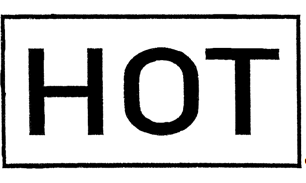


HOT - Registration of laudatory signs as trade marks
September 23, 2015
Categories:
Beitragsdatum:
23. September 2015 - 7:55
The European General Court (EGC) rules that a word with laudatory connotations may be registered as a trade mark if it does not specifically describe the goods and services and not all of its meanings are exclusively laudatory. (Judgement: T-611/13 of 15 July 2015)
Background of the Case and Subject Matter
On 13 August 2009, the World Intellectual Property Organisation (WIPO) approved the International Registration No. 0797277 of Effect Management & Holding GmbH for the word/device mark “HOT” for, in particular, cosmetics and sanitary products. The Office for Harmonisation in the Internal Market (OHIM) approved protection of the mark in the European Union on 26 November 2010 for Class 3 and 5. On 6 April 2011 the registration was challenged by Australian Gold LLC. They considered the mark to be purely descriptive and to lack a distinctive character. The Cancellation Division of OHIM partly upheld the cancellation action. The decision was appealed on 10 October 2012.
The question was whether the mark “HOT” is a laudatory term which exclusively describes certain characteristics of goods and services, or if it is laudatory in a broader sense i.e. if it refers to vague positive connotations without specifically referring to the goods and services themselves.
In the contested decision of 10 September 2013, the Fourth Board of Appeal declared that registration could only be rejected for “massage oils, gels” in Class 3 and “lubricant for pharmaceutical use” in Class 5. It was found that these goods are intended to be applied to the skin through repetitive motions, which creates a sensation of “heat”. For the remaining goods the Board ruled that the word “HOT” is neither descriptive nor lacks the necessary distinctiveness.
The Decision of the European General Court (EGC)
The EGC agrees that the mark “HOT” is descriptive for the goods “massage oils, gel” in Class 3 and “lubricant for pharmaceutical use” in Class 5. However, the Court rules that OHIM wrongfully concluded that the mark is not descriptive for “perfumes, essential oils, cosmetics” as “massage oils, gels” are mere examples of that broader category of goods, which is indicated by the word “including” within the list of goods in Class 3.
As for “washing and bleaching preparations; soaps” in Class 3 and “food supplements for medicinal purposes” in Class 5, the Court concludes that the word “HOT” is not describing the contested goods as it does not indicate the temperature of these goods. The positive connotations of the word “HOT” are too vague to create a direct link to these goods.
The Court refers to an earlier decision of the German Federal Court of Justice from 2014, where the word/device mark “HOT” was considered devoid of any distinctive character. The Court states that even though they may take rulings from national courts into consideration, they are in no way bound by their decisions.
On the contrary, the EGC makes an interesting statement regarding the distinctiveness of the mark. It rules that it is not sufficient in itself that the word “HOT” may have a sale promoting effect. In order to reject a mark it must be proven that the mark exclusively is a sale promoting slogan and thus lacks distinctiveness. The Court finds that Australian Gold LLC has failed to prove this as the word “HOT” has several meanings e.g. warm, spicy, appealing and attractive.
The European Court of Justice has in an earlier case ruled that it is sufficient for refusal of a trade mark that at least one of its possible meanings is descriptive in relation to the relevant goods and services (Doublemint C-191/01). The interpretation of the General Court in the “HOT”-case creates a tension with the earlier judgement. In addition, there have been some ambiguous results in earlier case law regarding registration of laudatory signs. This makes it hard to predict whether a laudatory sign will be considered sufficiently distinctive for registration in the future.
Related
- "Neuschwanstein" is not a trademark!
- 14 June 2013: Munich Patent Law Conference - Calculating Damages in Patent Infringement Cases
- 15 Top Brands - Interactive Brand Rating - Years 2000 - 2018
- 2014: Statistics for Community Trademarks
- 27 June 2014: Munich Patent Law Conference – Burden of Pleading and Proof in Patent Infringement Cases
- 3D-Trademark Protection for layout of Apple Stores
- 40th Anniversary of the European Patent Convention (EPC)
- A backpack shape as a 3D trademark – a BoA decision of the EUIPO
- A case of „Bounty“ hunting in Germany
- A new report on the economic impact of counterfeit trade published by OECD and EUIPO
